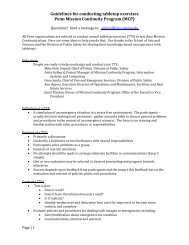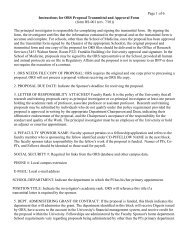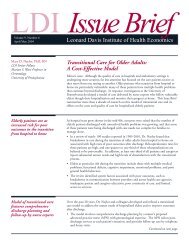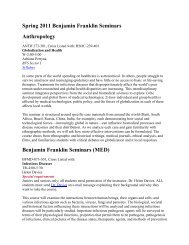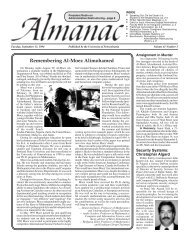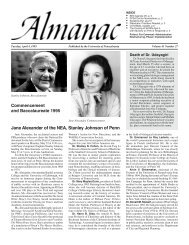2009-2010 COURSE REGISTER - University of Pennsylvania
2009-2010 COURSE REGISTER - University of Pennsylvania
2009-2010 COURSE REGISTER - University of Pennsylvania
You also want an ePaper? Increase the reach of your titles
YUMPU automatically turns print PDFs into web optimized ePapers that Google loves.
ANTHROPOLOGY<br />
(AS) {ANTH}<br />
L/R 001. Introduction to Archaeology.<br />
(C) History & Tradition Sector. All classes.<br />
Dibble or Sabl<strong>of</strong>f, J.<br />
An introduction to the history, concepts,<br />
and methods <strong>of</strong> the anthropological study<br />
<strong>of</strong> ancient peoples using archaeological<br />
illustrations to indicate the relationships <strong>of</strong><br />
archaeological interpretations with cultural<br />
and physical anthropology.<br />
L/R 002. Introduction to Cultural<br />
Anthropology. (C) Society Sector. All<br />
classes. Staff.<br />
An introduction to the study <strong>of</strong> culture and<br />
human institutions, how they change, and<br />
their role in both literate and nonliterate<br />
societies.<br />
L/R 003. Introduction to Human<br />
Evolution. (C) Living World Sector. All<br />
classes. Monge or Fernandez-Duque.<br />
How did humans evolve When did<br />
humans start to walk on two legs How are<br />
humans related to non-human primates<br />
This course focuses on the scientific study<br />
<strong>of</strong> human evolution describing the<br />
emergence, development, and<br />
diversification <strong>of</strong> our species, Homo<br />
sapiens. First we cover the fundamental<br />
principles <strong>of</strong> evolutionary theory and some<br />
<strong>of</strong> the basics <strong>of</strong> genetics and heredity as<br />
they relate to human morphological,<br />
physiological, and genetic variation. We<br />
then examine what studies <strong>of</strong> nonhuman<br />
primates (monkeys and apes) can reveal<br />
about our own evolutionary past, reviewing<br />
the behavioral and ecological diversity seen<br />
among living primates. We conclude the<br />
course examining the "hard" evidence <strong>of</strong><br />
human evolution - the fossil and material<br />
culture record <strong>of</strong> human history from our<br />
earliest primate ancestors to the emergence<br />
<strong>of</strong> modern Homo sapiens. You will also<br />
have the opportunity, during recitations, to<br />
conduct hands-on exercises collecting and<br />
analyzing behavioral, morphological, and<br />
genetic data on both humans and nonhuman<br />
primates and working with the Department<br />
<strong>of</strong> Anthropology's extensive collection <strong>of</strong><br />
fossil casts.<br />
L/R 004. The Modern World and Its<br />
Cultural Background. (B) Humanities<br />
& Social Science Sector. Class <strong>of</strong> <strong>2010</strong> &<br />
beyond. Kim, J. Also fulfills General<br />
Requirement in Society for Class <strong>of</strong> <strong>2009</strong><br />
and prior.<br />
An introduction to the diversity <strong>of</strong> cultures<br />
in the world. This course is divided into<br />
two parts. The first briefly examines<br />
different models <strong>of</strong> understanding human<br />
diversity: ethnicities, religions, languages,<br />
political forms, economic structures,<br />
cultures, and "civilizations". Students will<br />
learn to think about the world as an<br />
interconnected whole, and know the<br />
significance <strong>of</strong> culture on a global scale.<br />
The second part is an introduction to area<br />
studies, in which we undertake a survey <strong>of</strong><br />
the diffrent regions <strong>of</strong> the world. This<br />
semester we focus on Asia, specifically<br />
East Asia, Southeast Asia, Central Asia,<br />
and South Asia. We conduct the survey<br />
paying attention to the different aspects <strong>of</strong><br />
human diversities, which we examine in the<br />
first part <strong>of</strong> this course. Students will<br />
acquire a greater appreciation and<br />
understanding <strong>of</strong> cultural differences in the<br />
more comprehensive social context.<br />
L/R 012. (HIST012, SOCI012)<br />
Globalization And Its Historical<br />
Significance. (C) Humanities & Social<br />
Science Sector. Class <strong>of</strong> <strong>2010</strong> & beyond.<br />
Spooner.<br />
This course uses data from what is actually<br />
happening in the course <strong>of</strong> the semester to<br />
introduce the concepts and methods <strong>of</strong> the<br />
social sciences. It analyzes the current state<br />
<strong>of</strong> globalization and sets it in historical<br />
perspective. We will focus on a series <strong>of</strong><br />
questions not only about actual processes<br />
but about the growing awareness <strong>of</strong> them,<br />
and the consequences <strong>of</strong> this awareness. In<br />
answering these questions, we will<br />
distinguish between active campaigns to<br />
cover the world (e.g., Christian and Muslim<br />
proselytism, opening up markets,<br />
democratization) and the unplanned<br />
diffusion <strong>of</strong> new ways <strong>of</strong> organizing trade,<br />
capital flows, tourism and the Internet. The<br />
body <strong>of</strong> the course will deal with a series <strong>of</strong><br />
analytical types <strong>of</strong> globalization, reviewing<br />
both the early and recent history <strong>of</strong> these<br />
processes. The overall approach will be<br />
historical and comparative, setting<br />
globalization on the larger stage <strong>of</strong> the<br />
economic, political and cultural<br />
development <strong>of</strong> various parts <strong>of</strong> the modern<br />
world. The course is taught collaboratively<br />
by two social scientists: an anthropologist<br />
and a sociologist, <strong>of</strong>fering the opportunity<br />
to compare and contrast two distinct<br />
disciplinary points <strong>of</strong> view. It seeks to<br />
develop a concept-based understanding <strong>of</strong><br />
the various dimensions <strong>of</strong> globalization:<br />
economic, political, social, and cultural.<br />
At the end <strong>of</strong> the course students will<br />
understand the significance <strong>of</strong> globalization<br />
in the modern world, and be able to<br />
compare the approaches <strong>of</strong> different social<br />
sciences.<br />
ANTHROPOLOGY<br />
SM 018. (AFRC018, AFST018)<br />
Popular Culture in Africa. (C)<br />
Distribution Course in Society. Class <strong>of</strong><br />
<strong>2009</strong> & prior only. Barnes. Freshman<br />
Seminar.<br />
This course concentrates on popular culture<br />
in sub-Saharan Africa. It examines the way<br />
people reflect on and represent various<br />
aspects and issues in their daily lives, in<br />
public media, and through a diverse range<br />
<strong>of</strong> performative and creative outlets. It<br />
explores the way cultural traditions are<br />
created, promulgated, and perpetuated. It<br />
looks at the way popular culture deals with<br />
pleasure and pain; identity difference, and<br />
diversity; wealth and power; modernity and<br />
history; gender relations; suppression,<br />
resistance, and violence; and local versus<br />
global processes. In short, popular culture<br />
will serve as a window through which to<br />
observe contemporary life.<br />
SM 032. (LALS032) The Rise and Fall<br />
<strong>of</strong> Ancient Maya Civilization. (M)<br />
Distribution Course in Hist & Tradition.<br />
Class <strong>of</strong> <strong>2009</strong> & prior only. Sabl<strong>of</strong>f, J.<br />
Freshman Seminar.<br />
The civilization <strong>of</strong> the ancient Maya, which<br />
flourished between approximately 1000<br />
B.C. and the Spanish Conquest <strong>of</strong> the<br />
sixteenth century A.D. in what is now<br />
southern Mexico and northern Central<br />
America, has long been <strong>of</strong> wide public<br />
interest. The soaring temples <strong>of</strong> Tikal, the<br />
beautiful palaces <strong>of</strong> Palenque, the<br />
sophisticated carved monuments and<br />
sculpture, and the complex writing,<br />
astronomical, and mathematical systems <strong>of</strong><br />
this pre-industrial civilization have been<br />
widely photographed and written about.<br />
However, revolutionary advances in<br />
archaeological research which have<br />
provided important new data about the<br />
farmers and craftspeople who supported the<br />
great Maya rulers, and the decipherment <strong>of</strong><br />
Maya hieroglyphics writing over the past<br />
two decades have led to the overthrow <strong>of</strong><br />
the traditional model <strong>of</strong> Lowland Maya<br />
civilization and the growth <strong>of</strong> new<br />
understandings <strong>of</strong> the development <strong>of</strong><br />
Lowland Maya civilization, the rise <strong>of</strong><br />
urban states, and the successful adaptation<br />
to a difficult and varied tropical<br />
environment. Through a series <strong>of</strong> case<br />
studies, this seminar will examine the<br />
research that has led to these new insights<br />
and will evaluate the exciting new models<br />
<strong>of</strong> Maya civilization and its achievements<br />
that have emerged in recent years.<br />
SM 086. Desire and Demand: Culture<br />
and Consumption in the Global<br />
Marketplace. (M) Diggs-Thompson.<br />
Freshman Seminar.<br />
Page 23





